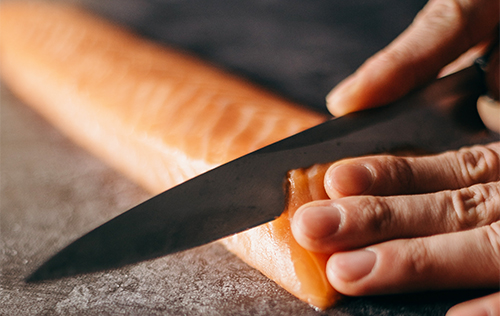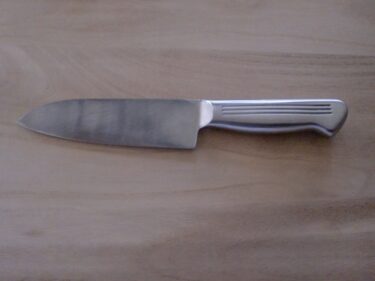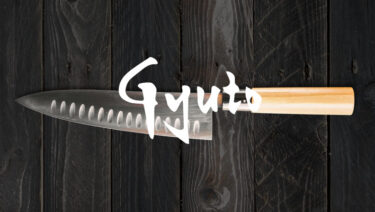Sashimi knives are specially designed for cutting sashimi, a typical Japanese dish.
This knife features a beautiful long blade, and even just looking at it, you can feel the high level of sharpness.
Sashimi knives are popular knives that not only professional cooks, but also fishing enthusiasts and people who buy fish fillets from the block and make sashimi should have at least once, but there are many prices and types, and many people are not sure which one to choose.
This article provides basic information on Sashimi knives and how to choose the right one.
Usage and Features of Sashimi Knives
Sashimi knives are specially designed for slicing sashimi after fish has been cut. The blade is long, thin, and very sharp.
Blade length is usually from 21cm to 36cm. The reason why sashimi Knives are so long is that Sashimi should be cut in a single motion.
By cutting in a single motion, it keeps the fibers of the sashimi cut undisturbed and enhances the flavor of the sashimi ingredients.
Why Sashimi Knives are called Yanagiba Knives?
Sashimi Knives are generally called Yanagiba knives. In fact, there are two types of Sashimi knives that are Yanagiba knives and Takobiki knives.
Yanagiba Knife

Yanagiba knives have been used mainly in the Kansai region, but nowadays, Yanagiba knives are mainly used in the Kanto region as well. Therefore, the term “sashimi knife” has come to mean Yanagiba knives in general.
The name comes from the resemblance of the blade to a willow leaf.
Another name for it is 正夫(Shoubu).
The name Shoubu also comes from its resemblance to the leaves of the iris(菖蒲). Iris is pronounced “Shoubu” in Japanese.
Takobiki Knife

Takobiki knives are sashimi knives that have been used mainly in the Kanto region, but nowadays, Yanagiba knives are more commonly used even in the Kanto region.
They are characterized by their square blade edges.
How to Choose the Best Sashimi knife
“How should I choose a Sashimi knife?”
Here are some tips on how to choose a Sashimi knife.
Select the Length of the Blade
The length of the blade of a Sashimi knife is determined based on the size of the cutting board and the cooking area.
The longer the blade, the easier it is to cut fish in a single slice, but the length of the blade should be shorter than the short side of the cutting board.
Also, if the cooking area is small, a long blade length is difficult to use.
Select the Blade Material
The material of the blade is also an important factor in choosing a Sahimi knife.
Steel
If you want to focus on sharpness, choose a Sashimi knife made of steel. The sharpness of the blade is much higher than that of other materials, and you can cut easily. However, they are prone to rusting and need to be cleaned frequently.
Steel can be further divided into two categories, blue steel and white steel, which can be further divided by number.
Steel can be further divided into two categories, blue steel and white steel, which can be further divided by number.
The smaller the number, the better the effect and the better the sharpness.
| Blue Steel | White Steel | |
|---|---|---|
| #1 | Sharpness:★★★★★ Durability:★★★★☆ Ease of Sharpening:★☆☆☆☆ | Sharpness:★★★★★ Durability:★☆☆☆☆ Ease of Sharpening:★★★☆☆ |
| #2 | Sharpness:★★★★☆ Durability:★★★★★ Ease of Sharpening:★★☆☆☆ | Sharpness:★★★★☆ Durability:★★☆☆☆ Ease of Sharpening:★★★★☆ |
| #3 | – | Sharpness:★★★☆☆ Durability:★★★☆☆ Ease of Sharpening:★★★★★ |
Stainless Steel
If you are looking for a knife that is easy to clean, I recommend a stainless steel Sashimi knife. Stainless steel knives are slightly less sharp than steel knives, but they are rust-resistant and easy to sharpen, making them suitable for beginners and those who do not want to spend too much time on maintenance.
Ceramic
Ceramic is lightweight and non-metallic, so it will not rust. It is suitable for slicing because it can maintain a certain strength even though it is thin, but it is not suitable for cutting hard food because it chips easily. Ceramic is also odor resistant, so it does not leave fish smells behind.
Select a Handle
The handle is also important in choosing a Sashimi knife.
There are two types of handles, one integrated with the blade and the other separated, mainly made of stainless steel.
The advantage of the integrated type is that it does not accumulate dirt and is easy to clean. The separate type may accumulate dirt or lose its stability after a long period of use, but it looks luxurious.
Select According to Your Dominant Hand
Sashimi knives are basically single-edged for right-handed people, which is a feature of Japanese knives.
This is not to say that left-handed people can’t use it, but it will be a bit difficult to use. If you are left-handed, you should choose a left-handed knife, although it will be slightly more expensive.
What is the Best Way to Care for a Sashimi Knife?
Sashimi knives are knives for which sharpness is especially important.
Especially when using a steel sashimi knife, handle it carefully by wiping off the water frequently not only after use but also during use.
After use, wash it with detergent, wipe off the water, and dry it.
In addition to these basic maintenance procedures, it is also necessary to sharpen it with a whetstone.
Refer to the following video to purchase a whetstone and adjust it for sharpening.
When sharpening the back side of a single-edged Japanese kitchen knife, the important back push will be distorted if the grindstone is not resurfaced and made flat.
Summary
Sashimi knives are specialized for cutting sashimi, and are characterized by their long blade length and sharpness.
If you are looking for a sharp cutting edge, you should use steel. For ease of care, steel is recommended.
Although it is difficult to maintain, if you are buying a sashimi knife, you may want to try a steel one.



